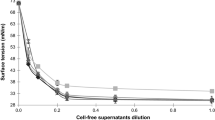Abstract
Growth ofP. putida andP. fluorescens on organic silicon compounds was investigated. Both strains could grow on low-molar-mass oligomeric organo-silicon compounds of M2D up to M2D5 type and on polydimethylsiloxanes with a viscosity higher than 1.46 Pa s (20 °C). Linear α, ω-polydimethylsiloxanediols were attacked only by a mixed culture of the two bacteria. Dodecaethoxypen-tasiloxane and tetraethoxysilane were rapidly degraded, yielding ethanol, trimethoxysilane was transformed to trimethylsilanol. Organosilicon compounds can thus be transformed by a specific microflora and in the natural environment degraded by a mechanism similar to that of other organic compounds.
Similar content being viewed by others
References
Buch R.R., Lane T.H., Annelin R.B., Frye C.L.: Photolytic oxidative demethylation of aqueous dimethylsiloxanols.Environ. Toxicol. Chem. 3, 215–222 (1984.
Fessenden R.J., Fessenden J.S.: The biological properties of silicon compounds.Adv. Drug Res. 4, 95–132 (1967).
Frye G.L.:Health and Environmental Aspects of Silicones. Soap, Cosmetics, Chemical Specialities. Dow Corning, Midland (Michigan) 1983.
Frye G.L.: The environmental fate and ecological impact of organosilicon materials.7th Internat. Symp. Organosilicon Chemistry, Kyoto (Japan); Lectures and Abstracts, p. 63 (1984).
Glazer M.A.: Silicone in protective coatings,Ind. Eng. Chem. 46, 2334–2342 (1954).
Hueck H.J.: Criteria for the assessment of the biodegradability of polymers.Int. Biodentn. Bull. 10, 87–90 (1974).
Ilyaletdinov A.V., Aliev R.M., Djusupova D.B.: Bacteria decomposing methylstyrene.Microbiologia 52, 609–614 (1983).
Klokoĉníková L.: The familyPseudomonaceae. Classification of bacteria 1986, pp. 60–66 in Collection of Papers (in Czech) from the seminar during the17th Congr. Czech. Soc. Microbiol., Ĉeské Budêjovice (Czechoslovakia) 1986.
Mahone L.G., Garner P.J., Buch R.R., Lane T.H., Tatera J.F., Smith R.C., Frye C.L.: A method for qualitative and quantitative characterization of waterborne organosilicon substances.Environ. Toxicol. Chem. 2, 307–313 (1983).
Pellenbarg R.: Silicones as trasers for anthropogenic additions to sediments.Marine Pollut. Bull. 10, 267–269 (1979).
Sharp R.F., Eggins H.O.W.: A biodeterioration appraisal of silicones.Int. Biodetn. Bull. 6, 19–26 (1970).
Wasserbauer R., Zadák Z., Novotný J.: Protective and antibacterial paints for asbestos-cement roodings of stables. (In Czech)Pozemní stavby 7, 314–316 (1983).
Author information
Authors and Affiliations
Rights and permissions
About this article
Cite this article
Wasserbauer, R., Zadák, Z. Growth ofPseudomonas putida andP. fluorescens on silicome oils. Folia Microbiol 35, 384–393 (1990). https://doi.org/10.1007/BF02821407
Received:
Revised:
Issue Date:
DOI: https://doi.org/10.1007/BF02821407




